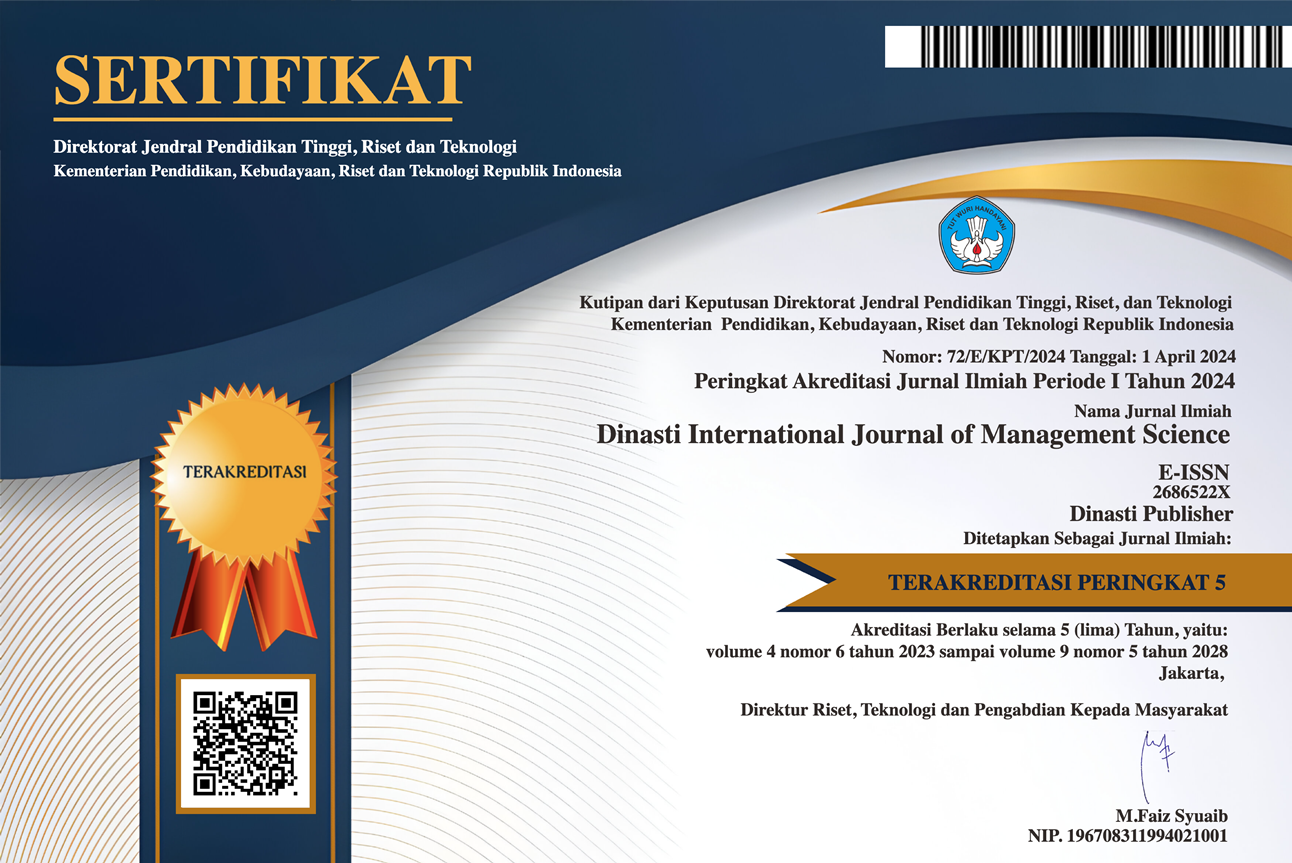Unlocking Economic Growth: How Market Size, Exchange Rates, And Corruption Shape Foreign Direct Investment
DOI:
https://doi.org/10.38035/dijms.v6i1.3478Keywords:
Market Size, Exchange Rate, Inflation, Corruption Perception Index, Information and Communication Technology, Foreign Direct Investment, Economic GrowthAbstract
This paper investigates the intricate relationships between market size, exchange rates, inflation, the Corruption Perception Index (CPI), Information and Communication Technology (ICT), and Foreign Direct Investment (FDI) on economic growth. Utilizing a panel data approach, the study analyzes data from Indonesia, China, and Singapore over the period 2019-2023, revealing that larger market sizes significantly attract FDI due to enhanced consumer potential and investment opportunities. Additionally, stable exchange rates are found to be crucial in mitigating risks associated with currency fluctuations, thereby increasing the attractiveness of a country for foreign investors. The findings also indicate that high levels of perceived corruption negatively impact economic growth by undermining governance and investor confidence. While the direct influence of ICT on economic growth was less pronounced, its role in enhancing operational efficiency and market access is acknowledged. The paper concludes with policy recommendations aimed at fostering a conducive investment environment through market expansion, exchange rate stability, anti-corruption measures, and ICT development. These insights contribute to a deeper understanding of the dynamics influencing FDI and provide a framework for policymakers to enhance economic growth in developing countries.
References
Alharthi, M., Islam, M. M., Alamoudi, H., & Murad, M. W. (2024). Determinants that attract and discourage foreign direct investment in GCC countries: Do macroeconomic and environmental factors matter? PLoS ONE, 19(2 February), 1–28. https://doi.org/10.1371/journal.pone.0298129
Bajpai, R., & Myers, C. B. (2020). Enhancing Government Effectiveness and Transparency?: The Fight Against Corruption. In Global Report (Issue September). http://documents.worldbank.org/curated/en/235541600116631094/Enhancing-Government-
Banna, H., Alam, A., Chen, X. H., & Alam, A. W. (2023). Energy security and economic stability: The role of inflation and war. Energy Economics, 126(December 2022), 106949. https://doi.org/10.1016/j.eneco.2023.106949
Chikwue, C. J. (2019). Effects of Exchange Rate on Foreign Direct Investment Inflow in Nigeria. South Asian Journal of Social Studies and Economics, 5(2), 1–12. https://doi.org/10.9734/sajsse/2019/v4i230123
Du, X., Zhang, H., & Han, Y. (2022). How Does New Infrastructure Investment Affect Economic Growth Quality? Empirical Evidence from China. Sustainability (Switzerland), 14(6), 1–30. https://doi.org/10.3390/su14063511
Dzanan, H., & Masih, M. (2017). Munich Personal RePEc Archive Does currency depreciation necessarily result in positive trade balance?? new evidence from Norway Does currency depreciation necessarily result in positive trade balance?? new evidence from Norway. (82103), 82103.
Elfaki, K. E., & Ahmed, E. M. (2024). Digital technology adoption and globalization innovation implications on Asian Pacific green sustainable economic growth. Journal of Open Innovation: Technology, Market, and Complexity, 10(1), 100221. https://doi.org/10.1016/j.joitmc.2024.100221
Fazaalloh, A. M. (2024). FDI and economic growth in Indonesia: a provincial and sectoral analysis. Journal of Economic Structures, 13(1). https://doi.org/10.1186/s40008-023-00323-w
Firman, F., & Munim, F. (2022). Corruption and Economic Growth in ASEAN-5 Countries. Jurnal Ekonomi Pembangunan, 20(1), 25–38. https://doi.org/10.29259/jep.v20i1.16131
Gkrimpizi, T., Peristeras, V., & Magnisalis, I. (2023). Classification of Barriers to Digital Transformation in Higher Education Institutions: Systematic Literature Review. Education Sciences, 13(7). https://doi.org/10.3390/educsci13070746
Glynn, E. H. (2022). Corruption in the health sector: A problem in need of a systems-thinking approach. Frontiers in Public Health, 10(1). https://doi.org/10.3389/fpubh.2022.910073
Grace, G. (2019). Factors Affecting Inward Foreign Direct Investment: Case of Asean Countries. Info Artha, 3(2), 119–132. https://doi.org/10.31092/jia.v3i2.588
Hooy, C. W., Ali, R., & Rhee, S. G. (2013). Emerging markets and financial resilience: Decoupling growth from turbulence. Emerging Markets and Financial Resilience: Decoupling Growth from Turbulence, October, 1–252. https://doi.org/10.1057/9781137266613
Ilmas, N., Amelia, M., & Risandi, R. (2022). Analysis of the Effect of Inflation and Exchange Rate on Exports in 5-Year Asean Countries (Years 2010–2020). Jurnal Ekonomi Trisakti, 2(1), 121–132. https://doi.org/10.25105/jet.v2i1.13561
Iloie, R. E. (2015). Connections between FDI, Corruption Index and Country Risk Assessments in Central and Eastern Europe. Procedia Economics and Finance, 32(15), 626–633. https://doi.org/10.1016/s2212-5671(15)01442-2
Indrawati, S. M. (2022). Keeping Indonesia Safe From the COvid-19 Pandemic.
Kennedy, P. S. J. (2018). The Effect Of Corrupt Behavior On The Flow Of Foreign Direct Investment To Indonesia. Asia Pacific Fraud Journal, 3(1), 153–162. https://doi.org/10.21532/apfj.001.18.03.01.18
Kusairi, S., Wong, Z. Y., Wahyuningtyas, R., & Sukemi, M. N. (2023). Impact of digitalisation and foreign direct investment on economic growth: Learning from developed countries. Journal of International Studies, 16(1), 98–111. https://doi.org/10.14254/2071-8330.2023/16-1/7
Mahmood, H., Tanveer, M., Omerovi?, E., & Furqan, M. (2021). Rule of law, corruption control, governance, and economic growth in managing renewable and nonrenewable energy consumption in south asia. International Journal of Environmental Research and Public Health, 18(20). https://doi.org/10.3390/ijerph182010637
Millia, H., Ernawati, E., & Heriberta, H. (2023). Do foreign direct investment, trade and their interactions affect economic growth in Indonesia? Jurnal Perspektif Pembiayaan Dan Pembangunan Daerah, 11(1), 1–16. https://doi.org/10.22437/ppd.v11i1.22698
Nguyen, C. D. T. (2023). The Link between Foreign Exchange Rate and Foreign Direct Investment: Case from Vietnam. Review of Economics and Finance, 21(August), 1109–1115. https://doi.org/10.55365/1923.x2023.21.123
Rahmawati, A., Wahyuni, E. T., Saputra, V. P., & Asiyah, B. N. (2023). Strategies to Maintain Economic Stability in the Era of Inflation: An Islamic Perspective. Proceedings of Islamic Economics, Business, and Philanthropy, 2(2). https://jurnalfebi.iainkediri.ac.id/index.php/proceedings/article/view/1120
Rane, N., Achari, A., & Choudhary, S. P. (2023). Enhancing Customer Loyalty Through Quality of Service: Effective Strategies To Improve Customer Satisfaction, Experience, Relationship, and Engagement. International Research Journal of Modernization in Engineering Technology and Science, May. https://doi.org/10.56726/irjmets38104
Report, I. (2024). INVESTMENT REPORT 2023/2024 Transforming for competitiveness.
Rezki, J. F., Sabrina, S., Desgiani, N. A., Riefky, T., Cesarina, A., & Husna, M. (2021). The Great Escape: COVID-19 in the Short-Term and Middle-Income Trap in the Long-Term. Macroeconomic Analysis Series, Indonesia Economic Outlook, 1–18. https://www.lpem.org/wp-content/uploads/2020/11/IEO2021-EN.pdf
Ridha, M. R., & Budi Parwanto, N. (2020). The Effect of Foreign Direct Investment, Human Development and Macroeconomic Condition on Economic Growth: Evidence from Indonesia. Journal of Indonesian Applied Economics, 8(2), 46–54. https://doi.org/10.21776/ub.jiae.2020.008.02.5
Shaari, M. S., Esquivias, M. A., Ridzuan, A. R., Fadzilah Zainal, N., & Sugiharti, L. (2022). The impacts of corruption and environmental degradation on foreign direct investment: new evidence from the ASEAN+3 countries. Cogent Economics and Finance, 10(1). https://doi.org/10.1080/23322039.2022.2124734
Sriyana, J. (2022). Fiscal and monetary policies to reduce inflation rate in Indonesia. Jurnal Kebijakan Ekonomi Dan Keuangan, 1(1), 82–91. https://doi.org/10.20885/jkek.vol1.iss1.art8
Suhari, Hwihanus, S. R. (2023). Analisis Pengaruh Inflasi, Nilai Ekspor, Impor, dan Investasi Terhadap Pertumbuhan Ekonomi dan Pendapatan Perkapita Indonesia Tahun 2023:Pendekatan Regresi Data Panel. Jurnal Ekonomi Bisnis Dan Dosial Sains, 02(2), 1–21. https://doi.org/10.38156/worldview.v2i2.334
Surya, B., Menne, F., Sabhan, H., Suriani, S., Abubakar, H., & Idris, M. (2021). Economic growth, increasing productivity of smes, and open innovation. Journal of Open Innovation: Technology, Market, and Complexity, 7(1), 1–37. https://doi.org/10.3390/joitmc7010020
Susilo, D. (2018). The Impact of Foreign Direct Investment on Economic Growth (a Causal Study in the United States). Economics and Education, 4(1), 72–85. https://doi.org/10.55439/eced/vol24_iss6/a4
Syadullah, M., & Setyawan, D. (2021). The impact of infrastructure spending on economic growth: A case study of Indonesia. Communications - Scientific Letters of the University of Žilina, 23(3), A184–A192. https://doi.org/10.26552/COM.C.2021.3.A184-A192
Ta, V. L., Do, A. D., Phan, T. U., Nguyen, Q. H., Nguyen, T. T. H., Le, T. D., & Nguyen, T. P. (2021). Factors Affecting FDI Intentions of Investors: Empirical Evidence from Provincial-Level Data in Vietnam. Journal of Asian Finance, Economics and Business, 8(4), 0125–0134. https://doi.org/10.13106/jafeb.2021.vol8.no4.0125
Tu, N. A. (2024). Innovation and foreign direct investment attraction in developing countries. Cogent Economics and Finance, 12(1). https://doi.org/10.1080/23322039.2024.2312386
U?urluay, K., & Kirikkaleli, D. (2022). Sustainable Technology in High-Income Economies: The Role of Innovation. Sustainability (Switzerland), 14(6), 1–16. https://doi.org/10.3390/su14063320
Zajacova, A., & Lawrence, E. M. (2018). The relationship between education and health: reducing disparities through a contextual approach. Physiology & Behavior, 176(5), 139–148. https://doi.org/10.4049/jimmunol.1801473.The
Zhang, Y., & Cheng, L. (2023). The role of transport infrastructure in economic growth: Empirical evidence in the UK. Transport Policy, 133(January), 223–233. https://doi.org/10.1016/j.tranpol.2023.01.017
Downloads
Published
How to Cite
Issue
Section
License
Copyright (c) 2024 Soni Suardi, Syaiful Syaiful, Muhamad Halilintar

This work is licensed under a Creative Commons Attribution 4.0 International License.
Authors who publish their manuscripts in this journal agree to the following conditions:
- The copyright on each article belongs to the author(s).
- The author acknowledges that the Dinasti International Journal of Management Science (DIJMS) has the right to be the first to publish with a Creative Commons Attribution 4.0 International license (Attribution 4.0 International (CC BY 4.0).
- Authors can submit articles separately, arrange for the non-exclusive distribution of manuscripts that have been published in this journal into other versions (e.g., sent to the author's institutional repository, publication into books, etc.), by acknowledging that the manuscript has been published for the first time in the Dinasti International Journal of Management Science (DIJMS).
















































